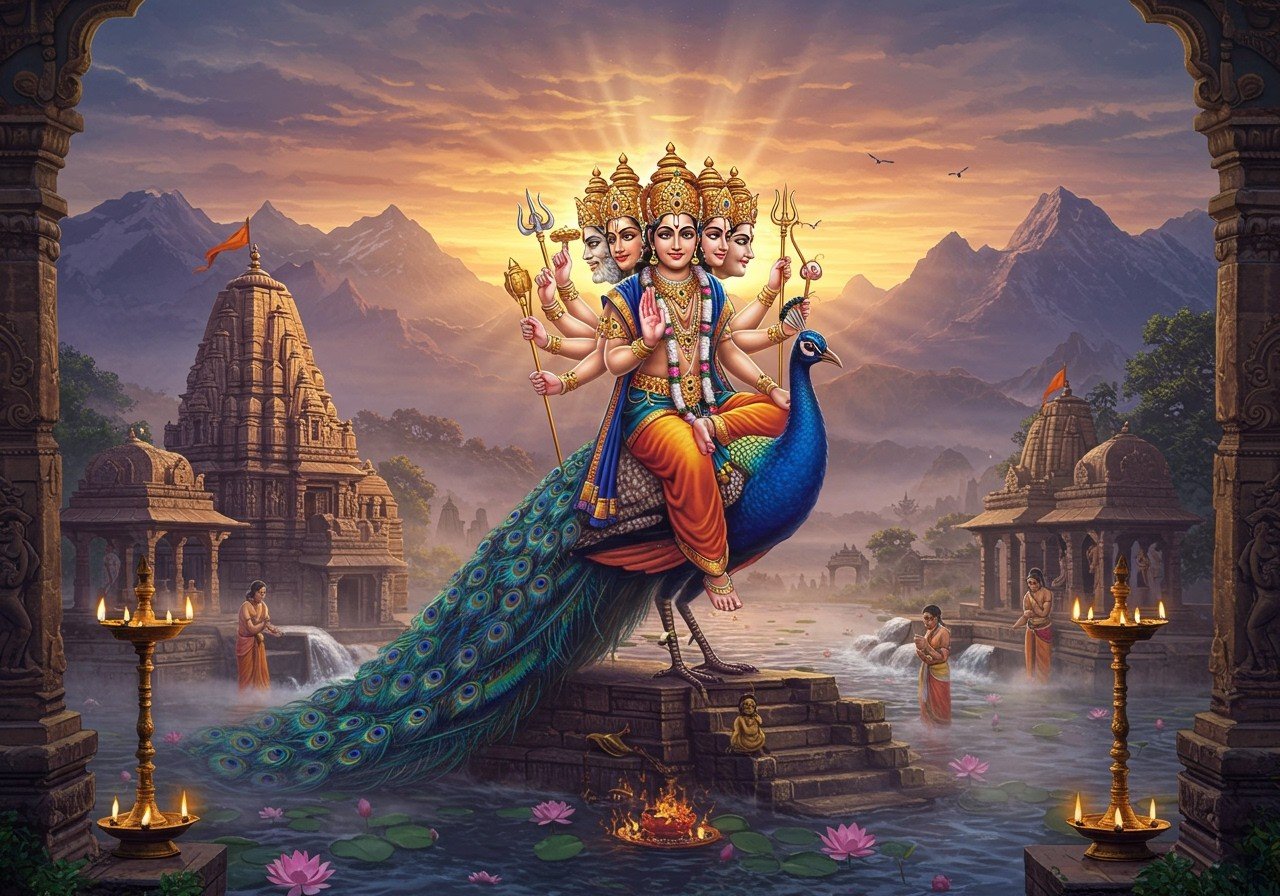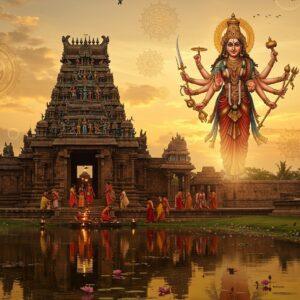
Embark on a spiritual voyage across India as we explore the temples of Lord Kartikeya, a significant part of the nation’s sacred heritage. Also known as Murugan, Skanda, or Subramanya, Kartikeya is a revered deity in Hinduism, especially among Tamil communities. Discover the rich history, architectural beauty, and cultural significance of Kartikeya’s temples scattered across India.
The Divine Significance of Kartikeya in Hinduism
Kartikeya, the son of Shiva and Parvati, is revered as the God of War and Victory, the commander of the celestial armies. His worship varies across India, symbolizing youth, power, and wisdom. Iconographically, he is often depicted riding a peacock and wielding a spear, signifying his warrior nature. Thaipusam and Skanda Sashti are major festivals dedicated to Kartikeya, marked by fasting and elaborate rituals.
Prominent Kartikeya Temples Across India
India is home to numerous renowned Kartikeya temples, each possessing a unique history and architectural style. The Arulmigu Dhandayuthapani Swamy Temple in Palani, Tamil Nadu, is a major pilgrimage site. The Thiruchendur Murugan Temple, located on the scenic shores of Tamil Nadu, is famous for its grand Skanda Sashti festival. At Swamimalai Murugan Temple, Kartikeya is said to have imparted the meaning of ‘Om’ to Lord Shiva. The Kukke Subramanya Temple in Karnataka is sought after by devotees seeking relief from sarpa dosha. Pazhamudircholai Murugan Temple, nestled in the lush hills of Tamil Nadu, offers serene surroundings and natural springs.
A Regional Exploration of Kartikeya Temples
The distribution of Kartikeya temples throughout India reflects cultural diversity and variations in regional worship. South India, especially Tamil Nadu, has a strong tradition of Kartikeya worship. Lesser-known temples in Kerala, such as Haripad Subramanya Swamy Temple, are known for their unique rituals. In North India, Kartikeya is often worshipped as a secondary deity within Shiva temples. Maharashtra houses temples like the Siddhivinayak Mahaganapati Temple in Titwala, where Kartikeya is venerated alongside Ganesha.
Planning Your Pilgrimage: Tips and Recommendations
A pilgrimage to Kartikeya’s temples is a deeply meaningful journey. Consider timing your visit with major festivals like Thaipusam or Skanda Sashti to witness vibrant rituals and community gatherings.
Factor in the regional climate while planning. Visiting the Pehowa Kartikeya Temple in Haryana during cooler months offers a comfortable experience. If you’re traveling to the Kartik Swami Temple in Uttarakhand, prepare for a scenic trek at a high altitude.
Transportation options vary regionally. South Indian temples, particularly in Tamil Nadu, are well-connected. For instance, Palani Murugan Temple is easily accessible by train. Reaching remote North Indian temples might require combined train and road travel.
Accommodation ranges from basic to comfortable, especially near significant pilgrimage sites like Thiruchendur Murugan Temple. Many temples provide free meals (annadanam). For those seeking traditional authenticity and modern convenience, poojn.in offers essential ritual items online, ensuring you’re prepared for offerings and ceremonies.
Understanding temple customs is essential. Dress modestly and observe local etiquette for prayers and offerings. Each temple may have specific practices. Before embarking on your pilgrimage, it is a good idea to purchase necessary items like a brass dhoop dani or a brass Kartikeya idol.
Cultural Experiences Along the Pilgrimage Route
Immerse yourself in the cultural richness that complements the pilgrimage. Local markets offer traditional crafts and regional delicacies. Tamil Nadu’s vibrant bazaars near Swamimalai Murugan Temple are particularly famous. Participating in temple festivals offers deeper cultural immersion, with processions, music, and dance reflecting community devotion. Local hospitality, including the tradition of annadanam, enhances the experience.
Exploring nearby attractions enriches the journey further. Near the Pazhamudircholai Murugan Temple, natural springs and serene hills invite reflection. A pilgrimage to Kartikeya’s temples is an opportunity to embrace India’s vibrant cultural heritage.
How Poojn.in Supports Your Temple Visits
Poojn.in offers essential items for worshipping Lord Kartikeya. For temple visits, we provide pure copper and brass vessels, traditional vastras, authentic kumkum and vibhuti sets, pure camphor and dhoop, Vel-shaped pendants, and peacock feather fans. For home worship, we offer brass and panchaloka Kartikeya idols, puja thalis, pure oil lamps, special incense sticks, Skanda Sashti puja items, and Murugan yantras. All items are verified for purity and ritual compliance, delivered across India with secure packaging.
Visit www.poojn.in or call our toll-free number for ordering. We ensure timely delivery.
[Note: Product availability and prices may vary.]
Embracing the Spiritual Journey
A pilgrimage to Kartikeya’s temples is more than a collection of memories; it is a soul-enriching experience deepening your understanding of faith, tradition, and community. Cherish the shared moments with fellow pilgrims, the serene landscapes, and the warmth of local hospitality. These experiences weave together a tapestry of spiritual and cultural fulfillment.
Whether a first-time pilgrim or seasoned traveler, Kartikeya’s temples offer a unique blend of devotion and discovery. Let this journey inspire you to explore India’s rich traditions while embracing the convenience of modern travel. May your pilgrimage be blessed with peace, joy, and a renewed sense of purpose.
FAQs on Kartikeya’s Temples: An Indian Pilgrimage Guide
Where are Kartikeya temples located in India? Kartikeya temples are found throughout India, concentrated in Tamil Nadu, Maharashtra, and Karnataka. Famous examples include the Arulmigu Subramaniya Swamy Temple in Tiruchendur and the Palani Murugan Temple. Other temples are spread across the country.
How can I locate a Kartikeya temple near me? Utilize online maps or local temple directories to find nearby Kartikeya temples. Many Indian cities, especially in the south, have dedicated temples.
When is the best time to visit Kartikeya temples? Festivals like Thaipusam and Skanda Sashti offer special rituals and celebrations, making them ideal times to visit. These times allow you to experience the temple at its most vibrant.
Why does Tamil Nadu have so many Kartikeya temples? Lord Kartikeya, known as Murugan, holds deep cultural and historical significance in Tamil Nadu, explaining the abundance of temples dedicated to him. The state has a long and rich tradition of Murugan worship.
Can I participate in rituals at Kartikeya temples? Many temples allow devotees to participate in rituals. Inquire with temple authorities about timings and procedures for participation, as each temple may have specific guidelines.
Are online services available for Kartikeya temple rituals? Many temples now offer online services for rituals and pujas. Consult the temple’s official website or contact them directly for information on online services and how to participate remotely.
What is the appropriate attire for visiting a Kartikeya temple? Modest, traditional attire is recommended, preferably Indian ethnic clothes like sarees for women and dhotis or kurta-pajamas for men. This shows respect for the sacred environment.
Is photography permitted inside Kartikeya temples? Photography rules vary by temple. Some prohibit photography within the inner sanctum. Check with temple staff for specific guidelines regarding photography and videography.


